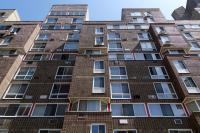London Southbank University
London, Great Britain
The new Student Centre at London South Bank University (LSBU) is a 2,000 sq m facility set within the university’s existing 1960’s tower block. It replaces an undercroft carpark, giving the development a vital facelift which improves the street frontage of the university and rationalises routes through the campus.
The Student Centre unites previously disparate facilities, the Students’ Union and Student Services, into a ‘First Stop Shop’ where students can access support services and find out more about employment opportunities, as well as occupy the space socially. It will provide an essential central hub to the University’s 23,350 students, two thirds of which are Londoners and 60% of which are over the age of 25.
The new Student Centre creatively redevelops a dingy external undercroft parking area and the existing bridge café above it, regenerating a prominent corner of the campus. It works with the existing structure of the original Brutalist architecture and maximises the spaces within it. The car park has been transformed into a vibrant new foyer with a double height glazed entrance, which affords greater transparency to the activities taking place in the building day and night.
Externally, anodised aluminium has been used to overclad the concrete, bringing a more contemporary feel to the campus whilst also improving the thermal performance of the building.
Internally a central void and rooflight at first floor level bring light into the foyer and ensure greater connectivity between the two floors. The work of David Bomberg, a prominent English painter, who taught at LSBU during the 1940’s and 50’s, provides inspiration for a bold geometric pattern on a feature wall in the foyer as well as in the hard landscaping at the Borough Road and Kell Street entrances. Inside the aesthetic is redolent of a boutique hotel lounge with ambient lighting and soft furnishings with splashes of colour, creating a convivial environment conducive to informal learning. This is an approach well rehearsed by the practice on higher education projects such as Coventry University Hub, Kent School of Arts, and Oxford University New Biochemistry.










